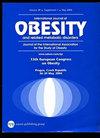身体活动在体重状况和影响日常活动的疼痛之间起到中介作用。
IF 3.8
2区 医学
Q1 ENDOCRINOLOGY & METABOLISM
引用次数: 0
摘要
背景:患有慢性疼痛的个体会经历身体活动(PA)、生活质量和身体能力的减少,形成一个衰弱的循环,其中PA减少和体重增加加剧了疼痛。本研究旨在通过全国代表性样本,考虑人口统计学因素,研究体重状况、PA和疼痛时间之间的关系。方法:利用2011-2012年NHANES周期的数据,比较体重状态和PA(总和类型)的疼痛组,并使用PA(总和类型)作为体重状态和疼痛时间之间的中介分析。结果:总PA组在疼痛程度上存在差异,剧烈运动组的“总是疼痛”患病率最低(5.4%),肥胖组的“总是疼痛”患病率(49.6%)高于正常体重组(19.5%)和超重组(30.9%)。总PA介导肥胖人群与疼痛时间的关系(效应:1.141;CI:0.456-1.837),也就是说,与体重正常的人相比,肥胖的人更不可能达到总PA指南,随后可能会花更多的时间在疼痛中。按类型细分PA,旅行PA(效应:0.071;CI:0.024-0.152)、中度娱乐性PA(效应:0.041;CI:0.018-0.079)、活力娱乐PA(效应:0.135;CI:0.035-0.279)显著调节了肥胖人群与疼痛天数之间的关系。结论:研究结果表明,有力的PA与较低的疼痛发生率有关。此外,PA显著调节肥胖人群与疼痛天数之间的关系。虽然超重个体本身与疼痛天数无关,但参与剧烈的娱乐活动与超重个体的疼痛天数减少有关,这凸显了保持活跃以控制疼痛的重要性。本文章由计算机程序翻译,如有差异,请以英文原文为准。

Physical activity mediates the relationship between weight status and pain impacting daily activities
Individuals who have chronic pain experience reductions in physical activity (PA), quality of life, and physical capabilities, creating a debilitating cycle where decreased PA and increased weight exacerbate pain. This study aimed to examine associations between weight status, PA, and time spent in pain using a nationally representative sample, accounting for demographic factors. Using data from the 2011–2012 NHANES cycle, a comparison of pain groups with weight status and PA (total and type) and a mediation analysis using PA (total and type) as a mediator between weight status and time spent in pain were conducted. Total PA groups differed in pain levels with those engaging in vigorous activity having the lowest prevalence in the "pain always" category (5.4%), and those with obesity had a higher prevalence of “pain always” (49.6%) compared to those with normal weight (19.5%) and those with overweight (30.9%). Total PA mediated the relationship between people with obesity and the amount of time spent in pain (effect:1.141; CI:0.456–1.837), that is, compared to those who have normal weight, those who have obesity were less likely to meet the total PA guideline, and subsequently likely to spend more days in pain. Breaking down PA by types, travel PA (effect:0.071; CI:0.024–0.152), moderate recreational PA (effect:0.041; CI:0.018–0.079), and vigorous recreational PA (effect:0.135; CI:0.035–0.279) significantly mediated the relationships between people with obesity and days spent in pain. Findings suggest that vigorous PA is linked to lower pain prevalence. Additionally, PA significantly mediates the relationship between people with obesity and days spent in pain. While people with overweight alone was not associated with the number of days spent in pain, engaging in vigorous recreational activities was linked to reductions in days spent in pain for individuals with overweight, highlighting the importance of staying active to manage pain.
求助全文
通过发布文献求助,成功后即可免费获取论文全文。
去求助
来源期刊

International Journal of Obesity
医学-内分泌学与代谢
CiteScore
10.00
自引率
2.00%
发文量
221
审稿时长
3 months
期刊介绍:
The International Journal of Obesity is a multi-disciplinary forum for research describing basic, clinical and applied studies in biochemistry, physiology, genetics and nutrition, molecular, metabolic, psychological and epidemiological aspects of obesity and related disorders.
We publish a range of content types including original research articles, technical reports, reviews, correspondence and brief communications that elaborate on significant advances in the field and cover topical issues.
 求助内容:
求助内容: 应助结果提醒方式:
应助结果提醒方式:


